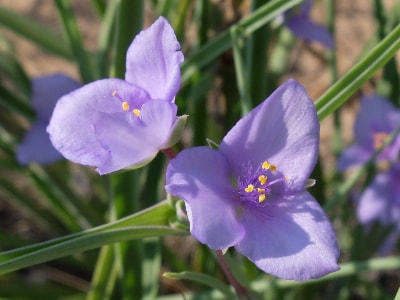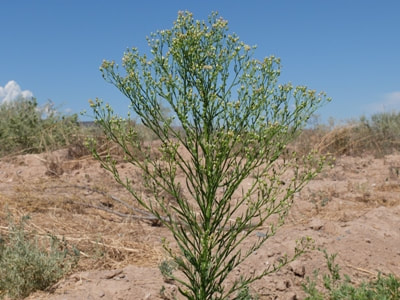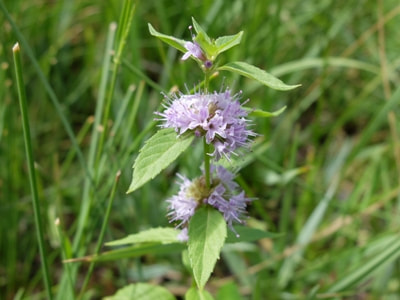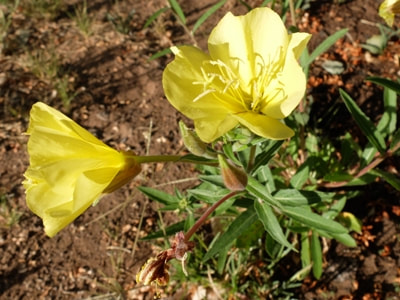|
Found in hot, sunny open areas
Seen blooming in August on the Madera Trail, Santa Fe National Forest Prairie Spiderwort grows to 20 inches tall with long, narrow, arching, grass-like leaves. Flowers grow in clusters and can be pink, purple or blue opening in the morning for a day. They are one to two inches across with three roundish petals and six stamens with long blue hairs topped by golden anthers. The cells of the stamen hairs of Prairie Spiderwort are normally colored blue, but when exposed to neutron radiation or other forms of ionizing radiation, the cells mutate and change color to pink. Thus the plant can be used as a bioassay for radiation. Source. There were bright pink flowers blooming on the trail. Native Americans ate the tender shoots of the Spiderwort as greens and used infusions of the root as a diuretic, an aphrodisiac, for internal injury and in a cut on the head 'to stop craziness.' Source. If you trying to identify a different flower then you can check what other flowers bloom this month. If you cannot identify a flower from the website send a photo and where you took it to contact@rockymountainsflora.com. Read online for tips.
0 Comments
Found in disturbed soil
Seen blooming in August by CR 142, Abiquiu This common annual weed grows from two to seven feet tall, making it hard to miss. It is identifiable by its solitary, upright, leafy stem which ends in a many-branched flower head of numerous tiny white and yellow flowers. The leaves are long and narrow becoming smaller as they ascend the stem. If you look closely at the flowers you will see that they have rays, though the white ray petals are only about 1 mm long. Although rather uninteresting in appearance Horseweed has many traditional uses. Young leaves and seedlings are edible. Dried leaves can be used as a seasoning with a tarragon-like flavor. An essential oil is used to flavor candy, condiments and soda. Horseweed was boiled to make steam for sweat lodges, taken as a snuff to stimulate sneezing during the course of a cold and burned to create a smoke that warded off insects. It is said to be a very effective treatment for bleeding hemorrhoids. A tea from the leaves was used to treat dysentery and a tea from the boiled root for menstrual issues. Horseweed has also been called Fleabane because the leaves put in pet’s beds help to get rid of fleas. Source. If you are trying to identify a different flower, then you can check what other flowers bloom this month. If you cannot identify a flower from the website send a photo and where you took it to contact@rockymountainsflora.com. Read online for tips. Found in sandy soils, grasslands, woodlands
Seen blooming in August in Plaza Blanca, Abiquiu Nodding Buckwheat grows from 2 to 20 inches high, usually about 10 inches, with many delicate, airy branches. It is quite common but easily bypassed because it has such tiny flowers. The leaves are roundish and low on the stem. The tiny flowers have white to pinkish ruffled petals and dangle from slender stalks that are less than 1 inch long. The whole plant turns maroon with age. Seeds were gathered by the Navajo (Diné) people, pounded into a meal, and eaten dry or made into a porridge. It was also used to treat rashes, kidney disease, and ant bites. Source. If you trying to identify a different flower then you can check what other flowers bloom this month. If you cannot identify a flower from the website send a photo and where you took it to contact@rockymountainsflora.com. Read online for tips. Found in moist areas, ditches, stream sides
Seen blooming in July by Acequia de La Puente This sweet flower is easy to miss amongst the grasses and sedges at water’s edge. Wild Mint grows from 6 to 18 inches tall with square stems. It has tiny lavender flowers growing in whorls where the upper leaves join the stem. The leaves are aromatic with a fresh minty flavor and are used to make tea and as an herb in various cuisines. According to Greek mythology, a beautiful nymph named Mentha was cursed by the goddess Persephone and turned into a Mint plant. Wild Mint has long been used as a folk remedy for a broad range of ailments, including gastrointestinal problems and sore throats. It has been found to have powerful antimicrobial, antifungal and antioxidant effects. Mint is used in food, drinks, indigestion aids, anti-inflammatories, cough medicines, creams, toothpaste, mouthwash, cigarettes, and more. An extensive list of uses can be found here. If you trying to identify a different flower then you can check what other flowers bloom this month. If you cannot identify a flower from the website send a photo and where you took it to contact@rockymountainsflora.com. Read online for tips. Found in disturbed moist areas, roadsides.
Seen blooming in July near the Rio Chama, Abiquiu. Tall Evening Primrose grows from three to six feet tall. The stem is stout and usually reddish with many long, narrow, willow-like leaves. At its top is a cluster of showy yellow flowers, two to three inches across, with four large petals and protruding yellow stamens. Only one or two flowers open at the same time. The flowers are fragrant, open late in the day and wilt the next morning, turning orange. The leaves, seedpods, and roots are edible. The seeds produce an oil that is said to reduce inflammation and is used in soaps and pharmaceuticals. Source. If you trying to identify a different flower then you can check what other flowers bloom this month. If you cannot identify a flower from the website send a photo and where you took it to contact@rockymountainsflora.com. Read online for tips. |
AuthorI am Marilyn Phillips, a native of England, whose love of nature and the outdoors from childhood brought me by a circuitous route to Crested Butte, Colorado in 1993 and 16 years later to northern New Mexico. My exploration of the many trails in these areas, my interest in wildflowers and photography, and career in computer system design came together in this creation. If you have any corrections, comments or questions, please contact me by email. Archives
September 2024
Categoriescopyright © 2020
|







 RSS Feed
RSS Feed